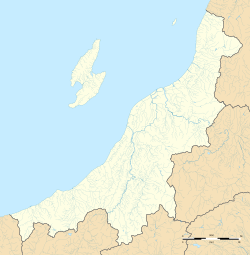Top Qs
Timeline
Chat
Perspective
Niigata Station
Railway station in Niigata, Japan From Wikipedia, the free encyclopedia
Remove ads
Niigata Station (新潟駅, Niigata-eki) is a major railway station in Chūō-ku, Niigata, Japan, operated by East Japan Railway Company (JR East).[1] The station is in the center of Niigata City, the largest city on the Sea of Japan coast in Honshu. It forms the central station for the railway infrastructure along the Sea of Japan coast, and is also the terminus of the Jōetsu Shinkansen high-speed line from Tokyo.
Remove ads
Remove ads
Lines
Niigata Station is served by the following lines.
Station layout
Summarize
Perspective
The station has two side platforms (former 1, 4) and two island platforms (former 2/3, and 8/9) at ground level serving a total of six tracks for conventional narrow gauge lines, of which only one island platform remains in use for trains originating from Niigata Station. This island platform (8/9) is an extension of one of the side platforms (1). The station also has two elevated side platforms 2, 5) and one island platform 3,4) serving conventional narrow gauge lines, and two more elevated island platforms serving four shinkansen tracks (11 to 14). The elevated station building has a "Midori no Madoguchi" staffed ticket counter and "View Plaza" travel agency.[1]
- Gate (Bandai Entrance)
- Ticket machines (Bandai Entrance)
- Elevated platforms
- Ground level platform No.8 and No.9
- Ground level platform No.1 (not in use)
- Sake Museum Ponshu-kan
Platforms
(Elevated)
| 1 | ■ - | (facilities not yet in place) |
| 2-5 | ■ Shinetsu Line | for Niitsu, Nagaoka, and Tsugawa |
| ■ Ban'etsu West Line | for Gosen and Aizu-Wakamatsu | |
| ■ Hakushin Line | for Shibata and Murakami | |
| ■ Uetsu Main Line | for Shibata and Murakami | |
| ■ Echigo Line | for Yoshida and Kashiwazaki | |
| 11-14 | ■ Joetsu Shinkansen | for Takasaki, Ōmiya, and Tokyo |
(Ground level)
| former 1-4 | ■ - | (not in use) |
| former 5-7 | ■ - | (facilities removed) |
| 8-9 | ■ Shinetsu Line | for Niitsu, Nagaoka, and Tsugawa (starting trains) |
| ■ Ban'etsu West Line | for Gosen and Aizu-Wakamatsu (starting trains) | |
| ■ Hakushin Line | for Shibata and Murakami (starting trains) | |
| ■ Uetsu Main Line | for Shibata and Murakami (starting trains) |
Remove ads
History
Niigata Station opened on 3 May 1904.[1] With the privatization of Japanese National Railways (JNR) on 1 April 1987, the station came under the control of JR East.
Passenger statistics
In fiscal 2017, the station was used by an average of 37,461 passengers daily (boarding passengers only).[2] The passenger figures for previous years are as shown below.
Remove ads
Surrounding area
- CoCoLo Niigata, shopping center in the station
- Sake Museum Ponshu-kan
 National Route 7
National Route 7 National Route 8
National Route 8- Bandai Bridge
Bus terminals

Both the Bandai Entrance and the South Entrance have bus terminals.[16][17] As of February 2017[update], the following transit bus line are on service.
Bandaiguchi Bus Terminal
- Niigata City Loop Bus[18][19]
- Transit bus operated by Niigata Kotsu[20]
- BRT "Bandai-bashi Line" : Niigata Sta.—Bandai Bridge—Furumachi—City office—Hakusan Station—Aoyama
- C* : for Central Niigata[21]
- S* : for South Niigata[22]
- W* : for West Niigata[23]
- E* : for East Niigata[24]
- "Sado-Kisen Line" : Niigata Sta.—Toki Messe—Sado Kisen Ferry Terminal
Minamiguchi Bus Terminal
- Transit bus operated by Niigata Kotsu
- Limousine bus for Niigata Airport
- C* / S* / W* / E*
Remove ads
References
External links
Wikiwand - on
Seamless Wikipedia browsing. On steroids.
Remove ads














